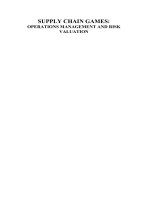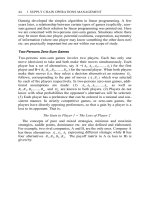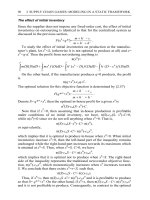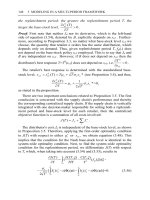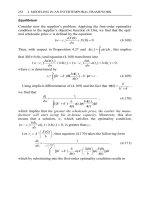Security operations management 2e robert mccrie
Bạn đang xem bản rút gọn của tài liệu. Xem và tải ngay bản đầy đủ của tài liệu tại đây (2.86 MB, 411 trang )
Security Operations
Management
SECOND EDITION
This page intentionally left blank
Security Operations
Management
SECOND EDITION
Robert D. McCrie
John Jay College of Criminal Justice,
The City University of New York
AMSTERDAM • BOSTON • HEIDELBERG • LONDON
NEW YORK • OXFORD • PARIS • SAN DIEGO
SAN FRANCISCO • SINGAPORE • SYDNEY • TOKYO
Butterworth-Heinemann is an imprint of Elsevier
Acquisitions Editor: Pamela Chester
Assistant Editor: Kelly Weaver
Project Manager: Jeff Freeland
Cover Designer: Eric DeCicco
Composition: CEPHA Imaging Private Limited
Printer/Binder: The Maple-Vail Book Manufacturing Group
Butterworth-Heinemann is an imprint of Elsevier
30 Corporate Drive, Suite 400, Burlington, MA 01803, USA
Linacre House, Jordan Hill, Oxford OX2 8DP, UK
Copyright © 2007, Elsevier Inc. All rights reserved.
No part of this publication may be reproduced, stored in a
retrieval system, or transmitted in any form or by any means,
electronic, mechanical, photocopying, recording, or otherwise,
without the prior written permission of the publisher.
Permissions may be sought directly from Elsevier’s Science & Technology Rights
Department in Oxford, UK: phone: (+44) 1865 843830, fax: (+44) 1865 853333,
E-mail: You may also complete
your request on-line via the Elsevier homepage (),
by selecting ‘‘Support & Contact’’ then ‘‘Copyright and Permission’’
and then ‘‘Obtaining Permissions.’’
Recognizing the importance of preserving what has been written, Elsevier prints
its books on acid-free paper whenever possible.
Library of Congress Cataloging-in-Publication Data
Application submitted
British Library Cataloguing-in-Publication Data
A catalogue record for this book is available from the British Library.
ISBN 13: 978-0-7506-7882-7
ISBN 10: 0-7506-7882-8
For information on all Butterworth–Heinemann
visit our Web site at www.books.elsevier.com
Printed in the United States of America
06 07 08 09 10 10 9 8 7 6 5 4 3 2 1
Table of Contents
Preface
Acknowledgments
PART I General Fundamentals and Competencies
1
2
3
4
5
6
Security Operations in the Management Environment
1
3
Core Competencies to Initiate Effective Protection Programs
29
Staffing to Meet Protective Goals
57
Training and Development for High Performance
95
Supporting and Motivating Supervisors and Staff
121
Appraising and Promoting People in Security Programs
155
PART II Special Issues in Security Management
7
8
9
10
11
vii
ix
187
Discipline and Discharge
189
Accounting Controls and Budgeting
217
Operating Personnel-Intensive Programs
249
Operating Physical- and Technology-Centered Programs
285
Leadership for Optimal Security Operations
319
Appendix A
Appendix B
Appendix C
Glossary
Index
357
359
363
375
383
v
This page intentionally left blank
Preface
What does an enterprise expect from its managers, directors, and chiefs concerned with
protection of assets from loss? The organization—private, public, or not-for-profit—
expects leadership, analytical ability, relevant knowledge to solve problems, flexibility to
confront new situations, and sufficient experiential grounding to enhance sound judgment. The desired end product from the manager, director, or chief is effective action.
Security Operations Management is written for practitioners, students, and general
managers who are involved with or interested in managing security operations effectively.
The purpose of this book is not immodest: It seeks to bring order to the sometimes
chaotic task of protecting people, physical assets, intellectual property, and economic
opportunity. The volume endeavors to provide a structure to operate programs for the
benefit of the enterprise, and it wishes to relate such principles and practices clearly and
directly to readers.
Security programs in the workplace continue to grow robustly, a development that
began on an organized basis following the end of World War II and with the beginning
of the Cold War. In the past half-century, numerous voluntary and cooperative security
trade and professional organizations have been founded to serve rapidly expanding
workplace requirements. Some have segued from narrow, specific local issues to large
global entities that advance knowledge and provide support for protective endeavors.
(Some of these are found in Appendix A.) Protection-related issues are important
throughout the organization. Indeed, this book argues that security is fundamental and
critical to the maintenance and growth of the enterprise. Without security, vulnerability
is exploited and the organization fails. Therefore, protection-related issues appear regularly on board agendas. Security-related matters are of concern to workers at all levels of
the organization. Readers and users of this book need to be conscious of entry-level
employees through the denizens of the executive suite.
Despite the elemental importance of security, personnel in the field must never take
their positions for granted. Persons who manage security operations face ever-dynamic
changes. A brilliantly conceived program might increase the level of protection while
decreasing the significance of personnel required to operate it. The role of the security
manager, director, or chief must be to provide measurable value for the organization
today and also to search for reasonable new ways to aid the enterprise tomorrow.
This book is written with the implications of these trends in mind. It explores both
the problems and opportunities for protection management in contemporary organizations, and the ways in which security operations leaders constantly must demonstrate their
programs’ value.
vii
viii
PREFACE
This is a data-rich book. Numerous referential facts, research studies, and valuable
citations are found. In producing this second edition, the author revised the previous iteration completely, adding new examples and expanding the text by approximately onefifth. In most instances, new tables and research update the points previously
emphasized. However, in a few cases the tables from the first edition again reappear
because no substantive new research has occurred to alter what was published previously.
This book seeks to integrate the nascent but growing academic discipline of security management and homeland security encountered in both undergraduate and graduate schools
of business administration, as well as in academic programs in criminal justice.
Some of the book’s material is based on the academic framework of business school
management courses: Syllabi from general management courses at leading schools of
business administration were evaluated in the preparation of the early chapters. Then
information specific to protection management for operating optimal programs was integrated to the text. The book is written within the context of security management education at John Jay College of Criminal Justice, a liberal arts institution broadly focusing
on public service. John Jay was located in its earliest years within Baruch College, now a
highly regarded business and public affairs–oriented liberal arts institution. The libraries
of John Jay and Baruch were particularly helpful for the creation of this volume. Hence,
elements of criminal justice, business management, and public administration have influenced aspects of the content.
As a plus, the publisher has created a companion website for supplementary material. Please consult: />
Acknowledgments
A book of this sort is long in the making and incurs many debts along the way. In a general sense, the 450 or so authors of the papers of Security Journal, which I edited from
1989 to 1998, provided inspiration for much of the content of this book. Additionally,
the readers and news sources of Security Letter, which I have written since 1970, have
informed me of topical operational issues of concern to them. And readers of the first edition, particularly students and faculty at John Jay College, contributed to content found
in this new volume with their helpful critiques.
This book draws from many relevant papers from Security Journal as well as criminal
justice and management-oriented publications. Additionally, findings and recommendations
from the Academic/Practitioner Symposia sponsored by the ASIS Foundation have been
helpful in identifying material for inclusion. These symposia have been chaired by David
H. Gilmore; Carl T. Richards is vice chair. Serious work on revision of the first edition
began when I was an exchange professor at the National Crime and Operations Faculty
of the National Centre for Police Excellence in England. During that sojourn, the National
Police Library in Bramshill, Hook, Hampshire, proved to have excellent references of
help for this volume. Thanks to all the librarians there and at John Jay.
Many talented security practitioners and academics have provided me with
inspiration—knowingly or unknowingly—over the years. Surely, that list is long. Those
who must be included are: J. Kirk Barefoot; Ronald V. Clarke; John G. Doyle, Jr.; Martin
Gill; Robert A. Hair; William J. Kelly; Ira A. Lipman; Robert F. Littlejohn; Bonnie S.
Michelman; Lawrence J. O’Brien, Jr.; Hans Öström; Joseph Ricci; Richard D. Rockwell;
Joseph S. Schneider; Bo Sørensen; Michael J. Stack; and William Whitmore. I am deeply
indebted to those who read parts of the manuscript and provided guidance on how to
improve them. For this edition these included: Gerald L. Borofosky; Paul DeMatteis; John
Friedlander; Richard G. Hudak; William J. McShane; Walter A. Parker; and Peter
Tallman. Thanks also to so many unnamed others who contributed to the effort.
My associate, Luis A. Javier, tirelessly saw to numerous production and fact-checking
details in preparing both editions. And above all, deepest appreciation goes to Fulvia
Madia McCrie, without whom this book would never have been realized and who has
been of inestimable importance to getting this out. At Elsevier Butterworth-Heinemann
my warmest thanks go to Kelly Weaver for her spirited and patient nurturing of this edition. Jenn Soucy signed the book, and Pam Chester continued steadily with the project.
My appreciation also is extended to their colleagues for production of this edition.
—R.D. McC.
ix
This page intentionally left blank
PART
I
General Fundamentals
and Competencies
This page intentionally left blank
1
Security Operations
in the Management
Environment
Security management is ready and eligible to be considered as a management
science.
—Charles H. Davidson in Security Journal
To achieve optimal protective goals, security chiefs, directors, and managers must operate successful programs. The origins of certain management-related words clarify this
objective. The word “operate,” for example, is derived from the Latin operatus, the past
participle of the verb “to work”; hence, operations are concerned with exerting power or
influence in order to produce an effect. Security operations, therefore, are the processes
whereby the protective aims of the organization are to be achieved. Success does not
depend upon good intentions alone. Personal effort causes such desired changes to occur.
The security practitioner must assume correctly that his or her appropriate involvement
is consequential in achieving what needs to be done.
Operating security programs is not easy. Protection is an intrinsic factor in success
and continuity of an operation. Because of this, one might assume—falsely—that efforts
to protect assets would receive broad, largely uncritical support from senior management
and ownership. That’s not necessarily so. A paradox exists within the workplace: Freedom
results in creativity, spontaneity, and economic development, while at the same time
making abuses within the organization easier to occur. Therefore, controls that decrease
the possibilities of loss are implemented. However, these same controls may also decrease
creativity and efficiency. The art of the security practitioner is thus to encourage expression and achievement while making the control mechanisms reasonably unburdensome
to employees, visitors, vendors, and the public at large. The organization should flourish
without the appearance of constricting security operations.
This book considers the tasks of operating security loss prevention programs in
contemporary organizations. The principles involved are applicable in for-profit and notfor-profit corporations and within government units at all levels. Most of the organizational protective features are common to the concerns of general management. Indeed,
security operations are aspects within a broad management context. Therefore, the initial part of this chapter will consider the concepts that have helped shape management
practices in the 20th century and that are guiding it in the 21st.
3
4
SECURITY OPERATIONS
ORGANIZATIONS
AND
IN THE
MANAGEMENT ENVIRONMENT
MANAGERS
To understand what a manager does, it is essential to consider the ways in which organizations have evolved in modern public and private institutions. Management must be
rational in order to achieve long-term success. Therefore, the creation of organizations
and their successful achievement of desired objectives must be understandable both to
those within and outside the organization. This is true for security departments as well
as for every other operating unit.
What Is an Organization?
The word “organization” is derived from the Greek organon, meaning organ, tool, or
instrument, and is akin to work. Organizations are composed of groups of people bonded
by a purpose: a systematic scheme to achieve mutually agreed-upon objectives. Typically,
organizations might be divided into a bifurcated scheme: administrators (leaders and
planners) and functional members (followers and processors). These roles may be interchangeable according to different circumstances. Organizations are created, therefore, in
order to achieve objectives deemed desirable by leaders and planners of the organization,
by those who carry out tasks, or in some cases by both.
Emergence of the Chief Security Officer
Titles evolve over time, reflecting different ways in which work is perceived. For most of
the 20th century, the pre-eminent title in for-profit and institutional workplaces was
“president.” The word suggested someone who presided over an organized body. Near
the end of the 20th century, the long-revered title no longer fitted the creative and activist
roles of those expected to head dynamic enterprises. To be president and preside over an
assembly, a meeting, or an institution remained appropriate as a descriptive title, but for
the competitive environments a new title was needed.
The title “chief executive officer” (CEO) emerged. “Chief” derived from the Latin
caput, head, and designated the person who heads or is the principal or foremost officer.
The title became infectious. Within a few years, the treasurer became the chief financial
officer (CFO), the most important data processing employee became the chief information officer (CIO), and the most significant functional officer evolved into the chief operating officer (COO), usually the second most important employee in the management
hierarchy. Collectively, senior executives now numbered many chiefs and the expression
“C-level” (for chief-level) came to reflect the management level of greatest precedence in
making certain decisions.
In this context, a protection executive at a senior level came to be called “chief security officer” (CSO). The title was further solidified when a trade publication was launched
in 2002 called Chief Security Officer.
What Is a Manager or Director?
The word “manage” is derived from the Italian maneggiare, from mano, hand. Originally,
the word was related to the training, handling, and directing of a horse in its graceful or
What Is the Purpose of an Executive?
5
studied action. In the 16th century, the Italians were considered the trick-riders of Europe
and became instructors to young European nobles on the Grand Tour. Similarly in France,
manège became the managing of a horse. Later the word came to mean “direction,” from
mener, to lead. Over time, the word came to suggest in English and other languages the concept of controlling, directing, economizing, or coping with challenging and constantly
diversifying circumstances. A manager is a person who controls or directs an organization
in a desired, purposeful direction. The title of “director” usually outranks that of manager
and refers to the person who directs the work of managers and their subordinates.
What Is a Security Manager?
“Security” is defined as the protection of assets from loss. Each word in this definition
carries its own implications. The word “protection” means to cover or defend. The word
“assets” encompasses numerous possibilities of tangible and intangible resources of
value. Clearly, cash and physical property can be considered assets, but knowledgerelated activities and the opportunity to achieve a desired goal due to particular circumstances are also highly important assets. A chief security officer manager (or director) is
a person who protects identified assets through personnel, procedures, and systems under
his or her control. The goal is to achieve objectives—agreed upon with senior management—that also produce minimum reasonable encumbrances to overall operations.
A POINT ABOUT TITLES
Titles within the organization can change according to fashion. For most of the 20th century, the titles “president,” “executive,” “chief,” “director,” “manager,” and others had
specific meanings. They connoted positions within a hierarchy well understood by those
within and outside the organization. Such a hierarchy still exists, but title connotations
may neither be clear nor consistent and may vary from one organization to another.
Indeed, sometimes an executive (or manager) creates new titles for structural or motivational purposes (see Chapter 5). Thus, words like “deputy,” “associate,” “assistant,”
“managing,” “acting,” “senior,” and “junior” are parts of some titles that may serve to
provide the level of significance of the position. In this book the titles “chief,” “director,”
and “manager” often are used interchangeably, reflecting the person most responsible in
a particular context for achieving operational goals.
WHAT IS
THE
PURPOSE
OF AN
EXECUTIVE?
Executives and those with executive tasks—regardless of their titles—are responsible for the
planning and analysis of required programs. They are further responsible for implementation of such programs. Ultimately, the challenge to organizational leaders is to be effective
in achieving or surpassing the reasonably set goals of the organization. Peter F. Drucker
(1910–2005), a leading management consultant, argued that the primary strategy of work
is measured not in the brilliance of its conception, but in how well the desired goals were
actually achieved. The nature of work changes constantly, he observed.
6
SECURITY OPERATIONS
IN THE
MANAGEMENT ENVIRONMENT
According to Drucker, “knowledge workers” are the human capital through which
objectives are achieved. Knowledge workers are members of an organization whose effectiveness is realized though the use of information often accessed and partially analyzed
through technology. In The Effective Executive, Drucker posits that effectiveness is not
simply necessary as a managerial attribute; it is vital and can be learned through concerted effort, leading to still greater effectiveness. Drucker writes:
I have called “executives” those knowledge workers, managers, or individual
professionals who are expected by virtue of their positions or their knowledge
to make decisions in the normal course of their work that have significant
impact on the performance and results of the whole. They are by no means
a majority of the knowledge workers. For knowledge work too, as in all areas,
there is unskilled work and routine. But they are a much larger proportion of
the total knowledge workforce than any organization chart ever reveals.1
The effective security chief executive or manager is a person who can identify the problems and opportunities facing the organization, plan to resolve them, organize resources so
that the mission may be successfully achieved, deputize others to follow through on his or
her behalf, and then supervise the continuing operation. These responsibilities are spelled
out further in the next section.
WHAT IS
THE
STRATEGY
OF
MANAGEMENT?
“Management” refers to the way in which members of an organization make key decisions on how goods and services are produced. Management can also refer to the process
by which such goals may be achieved.
Throughout contemporary organizations, the strategy of management is accomplished via a process of identifying, analyzing, planning, organizing, deputizing, and
supervising activities common to the attainment of these goals. This process is systematic
in progressive order, and action is required to achieve objectives by members of the
organization. Once given authority to proceed, the manager sees to this process in each
link of the chain (see Box 1.1). Specifically, the concatenation of managerial tasks is as
follows:
1. Problem identification. The first organizational process step identifies
the need for desirable and required managerial action. This need may
be to commence a new program or initiative, to revise an old one, to
solve a problem, to seize an opportunity, to expand or contract
operations, or to handle still other options. The management process
begins by asking the question, “What needs be accomplished and
why?” It then grapples with the clarified requirements that emerge
from the following stages (see Box 1.1).
2. Analyzing and planning. Analyzing is the process of separating
something into its constituent parts or basic principles. This allows the
nature of the whole issue to be examined methodically. To analyze a
security problem, the practitioner seeks to collect all pertinent
What Is the Strategy of Management?
Box 1.1 The Security Management Process
Managers in modern organizations use a simple, logical process to achieve desired
goals. The problem or opportunity may differ in significance, and the time required
to adequately analyze and plan it also may vary. A major problem or opportunity
may require weeks or months to resolve, but the sequence of events remains the
same. Here’s an example:
Problem Identification. Assume that the organization is expanding and must create
a new facility to achieve desired production. This new facility will require a security program to protect its assets. How will it be created? Early in the process of
planning for such a facility, the responsible security director collects pertinent information so that an optimal security program may be designed. The size, condition,
employment, production requirements, environmental issues, potential problems,
and other issues will be considered, and the most problematic matters will be isolated. Then the director, often aided by others, completes additional tasks until the
program is fully implemented. The process is as follows:
1. Analysis and planning. The security director might collect and
analyze the following information about the new facility:
• Function of the new facility (what it does, its size and
significance)
• Site selection (for protective and risk-averse features of the
topography)
• Architectural and engineering involvement
• Local conditions where the facility is to be located (for
example, physical location, crime and traffic patterns)
• Local resources available (police, fire, emergency-oriented)
• Special security features likely to be required at such a facility
This process involves a fact-finding process in which the
manager, or a surrogate, visits the site to determine its potential
risks and opportunities so that these may be incorporated into the
formal plan. When as much relevant data is collected as possible in
the time available, the planning team is ready to prepare the physical security plan for the new facility. Planning for security measures
needed by the facility once it begins operating is also undertaken at
this time. The manager then discusses the analysis and planning
with senior management.
2. Organizing. The plan must now be accepted by relevant decision makers throughout the organization. Resources required for
the security program at the new facility are then mobilized. The
steps taken may include:
• Consulting with architectural and engineering personnel about
specific security design needs
7
8
SECURITY OPERATIONS
IN THE
MANAGEMENT ENVIRONMENT
• Issuing a request for proposal (RFP) for the system to
qualified contractors (Chapter 10)
• Establishing qualified bidders for the security project
• Reviewing submissions and awarding the contract
• Supervising the project’s installation
• Assuring adequate training and support materials
• Testing the system under normal and adverse circumstances
• Adjusting the system based on insights from the testing process
• Planning for future testing and improvements (Chapter 10)
At this point, a complex system has been created for the new
facility. Meanwhile, a security staff must be hired and procedures for
both security and nonsecurity personnel must be prepared and
reviewed. The next step assures these goals are met.
3. Deputize. As the new security system is configured and the operational commencement for the new facility can be scheduled, a
manager must run the enduring, ongoing security program.
Consequently, someone is deputized to assume this responsibility
on behalf of management at headquarters. He or she will carry
out the earlier aspects of the plan through the commencement
and subsequent routine operations of the new facility.
4. Supervise. The principal central manager’s time commitment for
the new facility gradually lessens as the deputy assumes control
of the new program or facility. That deputy reports regularly on
developments. The central manager maintains quality control
over the physical and procedural process involved in creating the
plan for the new facility.
5. Constant critical analysis and change. At this point, the managerial process has been completed. The time it takes to complete
the process varies considerably, depending on the particular
problem to be managed. It may take as little as a few hours by a
single individual or as much as months of concerted effort by a
managerial team. The process is dynamic; circumstances change
constantly, often in ways that could not have been anticipated early
in the planning period even by the most conscientious and rigorous
planners. Therefore, the manager must be prepared to constantly
refine the plan to new circumstances, seizing fresh opportunities for
further gains in programmatic objectives whenever possible.
information, which then becomes the basis of planning—or formulating—a
means to achieve the desirable goals. These are the critical next parts
of the managerial process. Wise managers generally do not proceed
to the next step in the sequence until the previous one is reasonably
completed. How much planning is enough? A manager is never likely
to have all the knowledge and facts necessary to comprehend every
What Is the Strategy of Management?
9
relevant facet to analyze fully and then plan comprehensively without
ever looking back. Further, conditions change constantly and create
new situations with which the manager must now contend. Yet at some
point, the analysis must be summarized when a reasonable quantity of
information has been collected and a plan for action has evolved. That
process of working with finite knowledge and resources is what is
fascinating and challenging about the art and method of management.
For example, in business continuity planning, operational issues
must be identified and assessed for their impact on the enterprise before
efforts to mitigate the risk begins. Figure 1.1 provides a grid that can be
used on paper or electronically to help estimate the impact and begin
the continuity strategy.
Impact Descriptors and Event Categorization
Type of Impact
and its Effects
Catastrophic
High
Medium
Low
Financial
Loss of revenue
Loss of value after
insurance recovery
Loss of shareholder
value
Penalties
Bad debts
Additional operating
costs
Non-Financial
Reputational loss
Loss of operational
opportunity
Customer service
Regulatory/legal
Loss of market share
Loss of quality
Brand tarnish
Environmental
Contractual
Staff morale
Political
FIGURE 1.1 Early in the continuity planning process, key assets and critical business
processes are identified. They can then be categorized according to likelihood of
occurrence and level of control possible. This grid can be use for different types of
untoward events, emergencies, and disasters with their collateral effects estimated.
Source: Control Risks Group.
10
SECURITY OPERATIONS
IN THE
MANAGEMENT ENVIRONMENT
3. Organizing. After the need has been determined, its critical parts have
been identified, and a plan has been established to respond to the
need, resources must be organized—that is, created or accumulated
in order to achieve the objective. Money and personnel must be
committed. Technology and software strategies may be required and
must be allocated. Impediments must be resolved. Commitments
must be assured. Then the plan can be implemented by selecting
subordinate managers and operational personnel.
4. Deputizing. A manager does not achieve the objectives of the plan
solely by his or her actions; a manager works in the company of others.
In the management process, the problem has been analyzed and a plan
to deal with it has been agreed upon. Resources have been committed
firmly. Now the process of assuring that the plan achieves its objectives
is shared with persons who will follow through—hopefully to realize
the intended goals. Persons deputized to achieve these ends on behalf
of the planning managers are themselves managers who are now
transferred the responsibility for assuring that the plan will be carried
out. The senior planning manager supervises this person or persons and
gradually becomes free to concentrate on other issues.
5. Supervising. The planning manager supervises the manager who has
been given responsibility (deputized) for achieving the goals set by the
plan. Through this process, the manager can assure that goals are
reached in the face of constantly changing circumstances. Thus, the
principal manager is engaged in controlling the work of others and
the allocation of resources in pursuit of the desired objectives. The
supervising manager in the hierarchy remains available to critique, and
supports and guides the manager deputized to carry out the plan. The
supervising manager now has time to concentrate on other matters,
such as identifying another need and planning its resolution or
supervising other operating programs.
6. Constant critical analysis and change. At this point, the planning
process has been completed from inception to realization. The
sequence may take as little as a few hours by a single individual or as
much as months of concentrated effort by a devoted managerial team.
Such a team could include internal managers, contract personnel, and
independent consultants retained for the project. However, although
the program may be functional, the process is never complete.
Circumstances change constantly, often in ways that could not have
been anticipated even by the most conscientious and rigorous planning
process. Therefore, the manager must refine the plan to fit the new circumstances, seizing new opportunities for further gains in programmatic objectives whenever possible.
For the program to succeed, wide participation in the enterprise is
desirable. All stakeholders need to be involved in the process, or at least
as many as practicable. As the testing process of the plan is completed,
managers conduct a gap analysis to isolate areas for improvement based
on impact to operations.
The Characteristics of Modern Organizations
THE CHARACTERISTICS
OF
11
MODERN ORGANIZATIONS
Contemporary organizations of a certain size and complexity must possess a pertinent
structure to achieve operational success. Civilization is about 5,000 years old, but the
Industrial Age arrived in Europe only in the mid-18th century and arrived decades later
in what would become the United States. The demands of constantly competing, expanding industrialization—coupled with expanding urbanism—created pressures on organizations for greater effectiveness. This process attracted the attention of seminal early
observers who first described evolving characteristics of the operational processes. These
observations created the basis for methodological observers who sought ways of improving industrial output. Much later still, security practitioners emerged to protect organizations in specific and distinctive ways.
The pivotal figures in this process may be divided into three categories: classical
management theorists, scientific management proponents, and some recent distinctive
contributors to security management practices.
Classical Management Theorists
Industrialization flourished following principles of expediency and common sense. In
time, the processes of production came under analysis and improvement. The first significant and comprehensive codification of management principles was provided by a
French mining engineer, Henri Fayol (1841–1925). He observed workplace processes,
which he then categorized into logical and distinct descriptives with broad applications
and significance:
• Division of work. In an organization of any size, labor is divided into
specialized units to increase efficiency. Work within organizations tends
to become increasingly specialized as organizations grow in size.
• Hierarchy. Organizations disperse authority to managers and
employees according to their formal positions, experience, and
training.
• Discipline. Good discipline exists when managers and workers respect
the rules that govern activities of the organization.
• Unity of command. No individual normally should have more than
one supervisor. Work objectives concerning tasks should relate
rationally among supervisors and subordinates. (Fayol derived this
point from his observations of military structure.)
• Chain of command. Authority and communication should be
channeled from top to bottom in the organization. However,
communication should flow from bottom to top as well.
• Unity of direction. The tasks of an organization should be directed
toward definable and comprehensible goals under the leadership of a
competent manager.
• Subordination of interests. The goal of the organization should take
precedence over individual desires. When personal agendas become
paramount, the goals of the organization cannot be achieved effectively.
12
SECURITY OPERATIONS
IN THE
MANAGEMENT ENVIRONMENT
• Remuneration. Pay and the total benefits package should be fair.
• Equity. Managers should be just and kind in dealing with subordinates.
• Stability of tenure. Management should plan so that positions are
stable. Reduction of positions (downsizing; “rightsizing”) may be
necessary during times of market and production downturn, but often
the reduction of previously budgeted positions reflects the failure to
plan and execute wisely.
• Order. The workplace should be orderly.
• Initiative. Employees should be encouraged to show personal initiative
when they have the opportunity to solve a problem.
• Teamwork. Managers should engender unity and harmony among
workers.
• Centralization. Power and authority are concentrated at the upper
levels of the organization. The advantages of centralization versus
decentralization are complex and may be regarded as a cyclical
phenomenon in management fashion; that is, despite a penchant for
centralization of organizational power, times may occur when
production is best achieved by decentralization of planning and much
decision making.
According to Fayol, all managerial activities can be divided into six functions:
1.
2.
3.
4.
5.
Technical (engineering, production, manufacture, adaptation)
Commercial (buying, selling, exchanging)
Financial (searching for an optimal use of capital)
Accounting (stock taking, balance sheets, cost analysis, statistical control)
Managerial (goal setting, analyzing and planning, organizing,
deputizing, supervising)
6. Security (protecting physical assets and personnel)
These six functions are always present, regardless of the complexity and size of an
organization. Thus, all organizational undertakings involve an interlinking of functions.
Note that security is identified as one of these fundamental activities of general management. Fayol observed that the security function “involves exposure identification, risk
evaluation, risk control, and risk financing.”2 In a remarkably insightful observation for
its time, he added:
Quite frankly, the greatest danger to a firm lies in the loss of intellectual property, a loss that the firm may attempt to prevent through patent protection,
trade-secret protection, signed agreements (nondisclosures) with key personnel,
and access to its innermost secrets on a strictly “need to know” basis.
Fayol’s prescient views held that security of know-how and opportunity take precedence
over physical assets, an opinion many contemporary security practitioners readily agree
with.
Fayol is regarded as a classical administrative theorist. Other pioneers of his genre
include Max Weber (1864–1920) and Chester Barnard (1886–1961). Weber, a German
sociologist and political economist, developed the term “bureaucracy,” which he described
The Characteristics of Modern Organizations
13
as the most rational form of an organization.3 The term comes from the French bureau,
or office, which originally stemmed from the earlier bure, woollen material used to cover
writing desks. According to Weber, large-scale tasks could be pursued by organizing
human activity as follows:
1. Activities directed toward meeting organizational goals are constant
and officially assigned.
2. Activities are controlled through a hierarchical chain of authority.
3. A system of abstract rules ensures that all operations are treated
equally.
4. Bureaucratic officials remain emotionally uninvolved while fulfilling
their formal duties.
Barnard, an executive for New Jersey Bell Telephone, emphasized that a “cooperative
system” generally is necessary for an organization to reach its goals. In The Functions of
the Executive, Barnard advanced a concept known as acceptance theory, concluding that
subordinates would assent to authority from supervisors and managers when four conditions were met:
1. They could and did understand the communications they received.
2. They believed that the communication was consistent with the purpose
of the organization.
3. They believed that it was compatible with their own personal interest.
4. They were mentally and physically capable of complying with the
communication.4
Thus, Weber underscored the importance of managerial structures to achieve desirable goals, and Barnard espoused that the principle that defined communications could
result in acceptance of the desires of bureaucracies by workers.
Scientific Management Proponents
Exponents of scientific management seek to use data collection and analysis to improve
work performance. The costly and time-consuming efforts required to save a few minutes
or seconds might seem like a frivolous activity to some; however, improved techniques,
when applied to a repetitive process on a large scale, pay generous rewards over time by
improving efficiency and lowering unit cost. Furthermore, the same process of job analysis could offer improvements in safety and work comfort.
Frederick W. Taylor (1856–1915) was a self-taught engineer who became chief
engineer of a steel company by the age of 28. His impressive early climb up the career
ladder was related to his ability to study work scientifically and then to apply the results
directly. His contributions had enormous influences on the workplace throughout the
20th century.5 Taylor’s principles are summarized as follows:
1. Determine what’s important in a task. Managers must observe and
analyze each aspect of a task to determine the most economical way to
put that process into general operation. The use of time studies helps
to establish what works best.
14
SECURITY OPERATIONS
IN THE
MANAGEMENT ENVIRONMENT
Example: Federal Express couriers delivering or picking up packages knock on a door before ringing the bell. Their studies have
revealed that customers respond faster to the knock-first-then-ring
sequence. Perhaps regular FedEx customers are conditioned to faster
response because they know who is at the door. Similarly, security
officers responding to an incident can be more productive and thorough by following a defined process that sequentially prompts them to
collect the essential facts about the event.
2. Select personnel scientifically. Taylor believed that all individuals were
not created equal. Training could help modify differences in behavior
and performance, but still some persons would be more effective than
others in performing the same tasks. It stands to reason, therefore, that
operations will be improved when managers concentrate on selecting
only those who show the best capacity to perform the job required.
Example: An organization may determine that its security personnel
must write clear, cogent reports of incidents. Therefore, a pre-employment
(vetting) test may be designed to ascertain how saliently candidates for
employment express themselves on paper.
3. Offer financial incentives. Selecting the right worker for the right
task does not by itself assure optimal effectiveness. Workers need
motivation, and hourly pay and benefits alone may not be sufficient to
achieve that goal. Taylor ascertained that providing a differential
piece-rate form of incentive can produce higher worker output than
would ordinarily be expected.
Example: The manager of an investigative department provides
incentive payments for those staff investigators who are able to complete
more investigations than the baseline expectation. Quality control assures
that such investigations meet or exceed expected standards of quality for
the assignments undertaken so that investigators seeking to achieve additional payments do not sacrifice standards to achieve higher benefits.
4. Employ functional foremanship or forewomanship. Taylor argued
that responsibility should be divided between managers and workers.
Managers primarily plan, direct, and evaluate the work; individual
workers are responsible for completing the designated tasks. Such
tasks as assigned by a supervisor would be largely similar. This permits
a worker to take orders from a functional foreman or forewoman
regardless of the stage of work because all manager-foremen
and-forewomen would understand the same work processes.
Example: Assume that a new security supervisor replaces another
normally responsible for a work unit. The goals of the workers being
supervised are identical. Since procedures to achieve these objectives are
understood by all workers, a new supervisor reasonably should be able to
achieve the same objectives with the workers as the regular supervisor
would have. Frank Gilbreth (1868–1924) and Lillian Gilbreth (1878–1972)
were a husband and wife team who translated Taylor’s scientific




